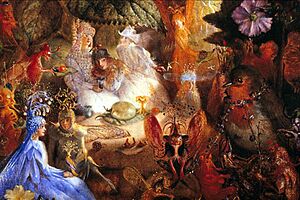Fairy painting facts for kids
Fairy painting is a special kind of art that shows fairies and scenes from fairy tales. Artists who create fairy paintings often add lots of tiny details. This style of art was very popular in the United Kingdom during the Victorian era (a time when Queen Victoria ruled). Today, this art style is becoming popular again. For many Victorians, looking at fairy paintings was a way to escape from their everyday lives.
Contents
How Fairy Painting Started
Fairy painting might look fun and light, but it has strong roots in plays and books from the Romanticism period. It also connects to the big changes happening in the Victorian era.
Shakespeare's Influence
Two very important influences were the fantasy plays by William Shakespeare: A Midsummer Night's Dream and The Tempest. These plays are full of magical creatures and faraway lands.
New ways of putting on plays helped bring these stories to more people. For example, gas lighting and better wire systems allowed for amazing special effects on stage. Even though one writer, Douglas Jerrold, once said A Midsummer Night's Dream could "only be acted by fairies," it became very popular. In 1863, there was a huge show where the famous actress Ellen Terry played Titania, riding a mechanical mushroom!
Why Victorians Loved Fairies
Big changes were happening in society during this time. The Industrial Revolution was changing old traditions. New science and technology, like photography, made some people feel confused or uncomfortable.
Some experts, like Jeremy Maas, believe that people turned to myths and fantasy, especially the world of fairies, to escape these changes. However, not everyone agrees. Andrew Stuttaford, for example, thought these paintings were "just about fun."
Victorian Fairy Art
Some of the earliest artists who painted fairies lived even before the Victorian era and the Romantic period. Henry Fuseli and William Blake created works that looked like later fairy paintings, even before 1800.
Richard Dadd's Detailed Art
However, the artist most famous for fairy painting was Richard Dadd. He created most of his art while staying in a special hospital for people with mental health challenges. Even with his condition, his amazing fantasy subjects and super detailed style were very popular. One reviewer at the time called his work "exquisitely ideal," meaning perfectly beautiful.
His most famous painting is The Fairy Feller's Master-Stroke, which he worked on from 1855 to 1864. He even wrote a long poem to go with it, explaining the story behind each character in the painting.
Other Famous Fairy Artists
Fairy painting wasn't just for artists like Dadd. The work of John Anster Fitzgerald was shown at London's Royal Academy. His Christmas-themed fairy pictures became even more well-known when they were printed in the Illustrated London News newspaper.
The Scottish artist Joseph Noel Paton showed two incredibly detailed paintings: The Quarrel of Oberon and Titania and The Reconciliation of Titania and Oberon. Both were based on the popular fairy scenes from Shakespeare's A Midsummer Night's Dream. Even Edwin Landseer, who was a favorite artist of Queen Victoria, painted a fairy scene. His painting, Scene from A Midsummer Night's Dream, shows Titania and Bottom in the fairy painting style.
Pre-Raphaelite Connections
The fairy art style also influenced the Pre-Raphaelite Brotherhood, a group of artists. John Everett Millais, one of the group's founders, painted several fairy scenes based on The Tempest. His 1849 painting Ferdinand Lured by Ariel was one of them.
Dante Gabriel Rossetti, another early member, explored fairy subjects in a more emotional way, both in his paintings and poems. Other artists linked to the Pre-Raphaelites, like Arthur Hughes and William Bell Scott, also created fairy art.
Interest in fairy art slowed down after the World War I began. The illustrated fairy-tale books by Arthur Rackham are seen as the "final flowering" of this Victorian art style.
Fairy Art Today
Since the 1970s, there's been a new interest in fantasy art and books. This has led to a revival of Victorian fairy painting styles, often in new ways.
Modern Artists and Media
Artists like Stephanie Pui-Mun Law create fairy illustrations for book covers and role-playing games. The works of Brian Froud, who is famous for his illustrated fairy books, have even been turned into successful movies like The Dark Crystal (1982) and Labyrinth (1986).
The concept art by Alan Lee and John Howe for The Lord of the Rings (film series) movies (2001–03) changed how many people imagine fairy cultures. Alan Lee even won an Oscar for his work!
The 2003 book The Art of Faery, written by David Riche and guided by Brian Froud, helped launch the careers of many new fairy artists. These include Amy Brown, Myrea Pettit, Jasmine Becket-Griffith, Philippe Fernandez, James Browne, and Jessica Galbreth. Many of them have gone on to create their own art books.
Fairies in Pop Culture
Fairies have also appeared in popular culture in other ways. You can find them on clothing, ceramics, figurines, and even in quilting. Many of these items are sold online to people all over the world.
Part of this growing popularity over the last 30 years is due to the New Age Movement. Events like Renaissance fairs and science fiction conventions have also helped modern fairy art become a popular type of collectibles.



